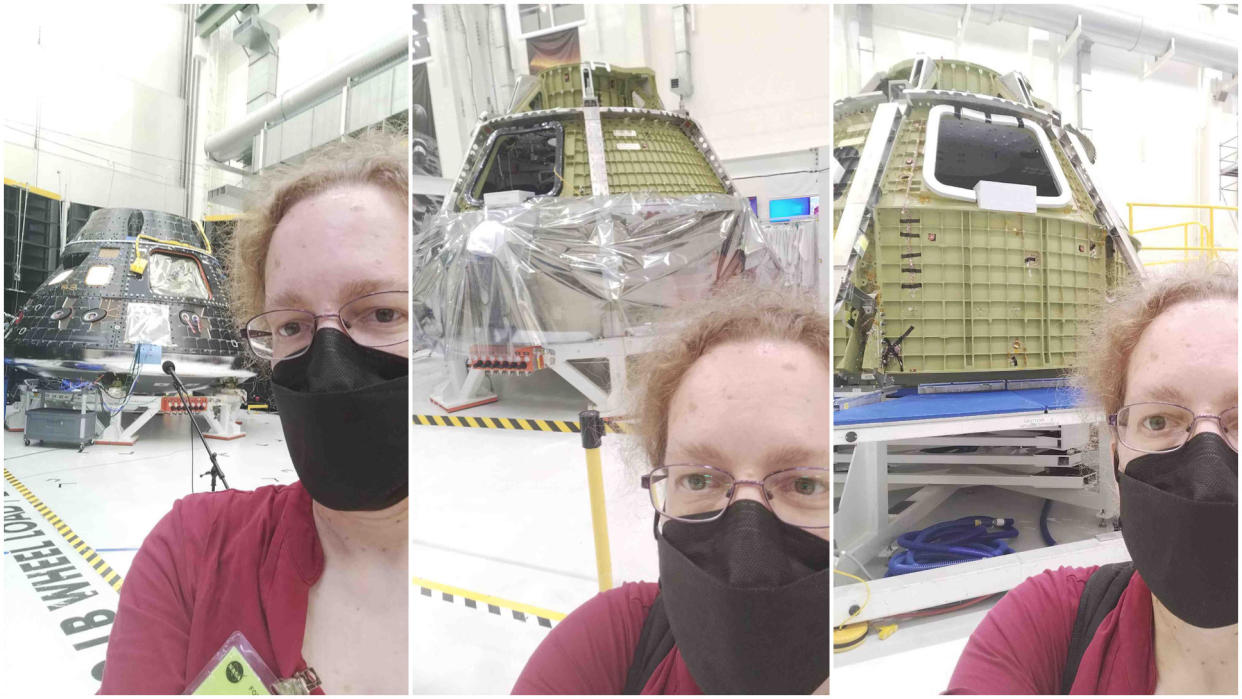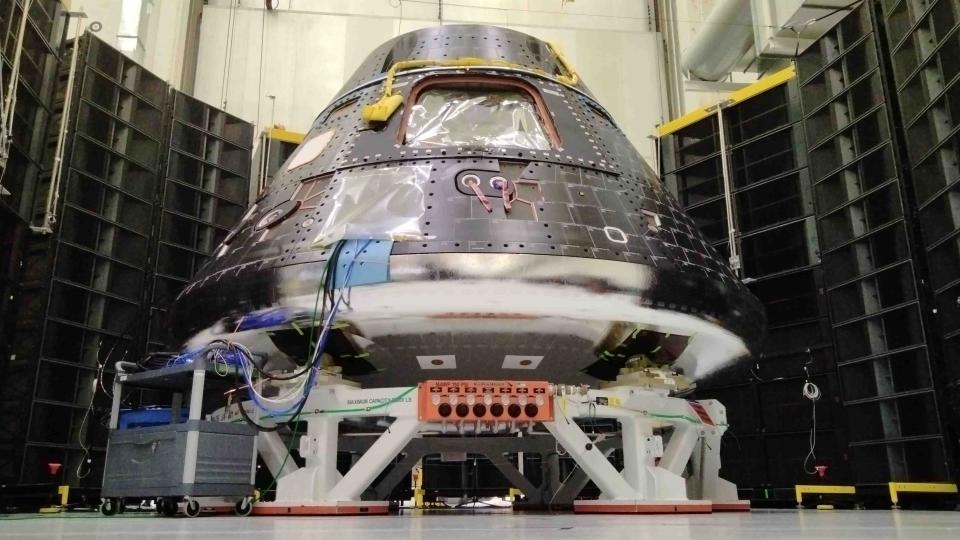This Artemis 2 tour showed me the 'Canadian genius' aiding NASA's next moon mission

- Oops!Something went wrong.Please try again later.
CAPE CANAVERAL, FLORIDA — The awe of Artemis already has a hold on me.
I was one of the few Canadians lucky enough on Aug. 8 to visit the Artemis 2 Orion spacecraft bound for the moon — and two other Artemis Orion spacecraft besides.
I could feel myself shaking in wonder while approaching the spacecraft at the checkout and operations building here at NASA's Kennedy Space Center (KSC), to talk with the crew. After 30 years following space closely — and 20 years reporting on it — the Apollo era I admired so long ago is coming back in style.
Canadian Space Agency astronaut Jeremy Hansen will fly on Artemis 2, along with three Americans. As such, NASA, the Canadian Space Agency and Space.com all worked hard to get me here from Canada on short notice, recognizing that it's important for Canadians to have somebody like me on site to show what this mission is about.
"This opportunity is allowing Canadians to bring their individual genius," Hansen told me in an individual interview on Aug. 7, the day before the KSC event. He cited space robotics, food and health as key Canadian contributions.
Related: Artemis 2 moon crew announcement felt like a Canadian history time warp
Canada was an early signatory of the NASA-led Artemis Accords, an international coalition of nations committing to moon exploration and peaceful space norms. My country is paying for the Canadarm3, an MDA-built robotic arm that aims to continue decades of robotic work in a new realm: NASA's planned Gateway lunar space station. In exchange, we get seats on some Artemis missions.
Canada is so well-regarded for the Canadarm series on the space shuttle and International Space Station that some compare the robotic series to incredible potato salad at a barbeque or picnic: robotics is the crucial side dish that makes space programs flow. Our specialties in space medicine, space food and artificial intelligence will also be helpful for future lunar programs, which themselves are designed to help pave the long road to Mars.
All of this work makes Canada a mighty minority on a mission full of crew diversity: Hansen will be the first non-American to circle the moon. Christina Koch, his NASA crewmate, will be the first woman to do so. Fellow NASA astronaut Victor Glover will be the first Black astronaut in that region. And commanding the group is Reid Wiseman, a NASA astronaut who has said how grateful he is for all the different perspectives the differences bring.
Supporting the crew are vast ground teams around the world, with dimensions of gender, ethnicity, nationality, income and so much besides. I am trying to tell some of these folks' stories through my privilege of visiting here, to represent the potential of what space can bring to some of us on the ground as well.
Related: How Artemis 2 astronauts are training for their 2024 moon mission
Kaileah Blazek, a mechanical systems and test engineer with Lockheed Martin, gave me a tour of the Artemis 4 spacecraft on the floor of the building at KSC. She has been with the program since 2020, joining just out of college through an internship.
"It's intense, at times, but we work hard and we're really motivated by the mission," she told me. Her team completed a key pressure test earlier this month, and the early results show that it went really well, she added.
"Basically, we plugged all the gaps in the vehicle," she said of the test, which pressurized Orion to 23 pounds per square inch, which is slightly more than what it is expected to withstand during crew operations. The team is now reviewing the data from the more than 700 sensors used during testing to prepare for future work.

RELATED STORIES:
— NASA's Artemis program: Everything you need to know
— Artemis 2 crew begins 1st moon mission training in 50 years
— Artemis 2 astronaut Jeremy Hansen says a Canadian will walk on the moon one day
The European Space Agency, another minority partner in the Artemis program, is making a big contribution of its own to Artemis hardware: the service module that keeps the Orion spacecraft running and healthy. I got a tour of the service module for Artemis 2 alongside Kai O'Bergemann, its deputy program manager.
"This module is providing everything the astronauts are needing during their mission," O'Bergemann said. "It provides oxygen, nitrogen, water, electricity, thermal control and finally the propulsion. And all of these things we call a service ... so we call this the service module."
And then there was the Artemis 3 capsule to look at. Standing in front of this spacecraft, I asked Matt Carroll, a technician at NASA's Orion production office, to show me around the spacecraft and talk about its readiness. The spacecraft is supposed to be finished in December 2024 or so and is roughly half-complete. "We have more welding to do, more life support systems, and a lot of the avionics still have to go on here," he said.
Artemis 3, which is slated to launch in 2025 or 2026, will land astronauts near the lunar south pole — the first crewed moon touchdown since Apollo 17 in 1972.
Canada will have many more stories of its own to share as we near the launches of these coming mission, including voices from key ground team members, scientists and other people helping Hansen execute his work in space.
I'm not the only person sharing the excitement of Canada being on this mission, as NASA !dministrator Bill Nelson told reporters during a NASA press conference on Aug. 8.
"You should have seen the reaction when Reid brought the crew to Ottawa and they were in front of the Parliament," he said, referring to the equivalent of the U.S. Capitol in the capital city of Canada. Nelson also paid tribute to Hansen's appearance at the Calgary Stampede in July and the crowds gathered there, to watch the astronaut in his "10-gallon hat."

